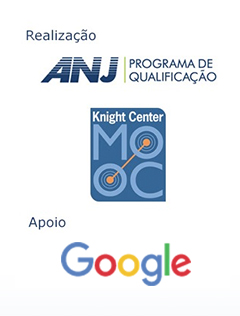
Reinventing the language of journalistic audiovisual production for the web was the main theme of the massive open online course (MOOC) “News video production for the internet.” It’s also what the fifteen students of the course who were selected to participate in a workshop on YouTube Space in São Paulo wanted to express in their projects.
More than 6,200 people from Brazil and other countries participated in this online course offered by the National Association of Newspapers (ANJ for its acronym in Portuguese) of Brazil and the Knight Center for Journalism in the Americas at the University of Texas at Austin, with Google’s support, between June 6 and July 3. This was a record number of participants for the Knight Center’s MOOCs in Portuguese and the second highest among its 24 massive courses offered to this point.
MOOC participants competed for 15 travel grants to go to YouTube headquarters in Brazil and participate in a unique workshop producing videos with the YouTube team on August 31. They will also personally meet the instructor João Wainer who taught the four-week course.
Among the selected projects, topics such as popular markets, street vendors, life in a fishing village hit by the mud of the ecological disaster of Mariana, Minas Gerais, and the LGBT pride parade were presented with a lot of creativity and investment on narrative elements that are similar to those of documentary films.
“Participants absorbed what I consider most important, which is the concept of this new videojournalism language for web. Much more than giving practical tips, what I always wanted with this course was to get people to learn to think of another way and realize the myriad of paths that this language allows, which go farther beyond conventional television journalism,” Wainer said.
“When I saw the students’ videos from the four corners of Brazil, made with such poetry and quality, it gave me great pride of having participated in this project,” Wainer said.
João Wainer was a founder of TV Folha and an editor there for several years. He won the Esso Award in Television Journalism category for coverage of the June 2013 protests. In this MOOC, he shared with the students some of his experiences and successes at TV Folha, where he sought to innovate and build a new language for video for a daily newspaper.
Following the lessons offered by the instructor, journalist Aline Silva, of Diário de Pernambuco, produced a video about the oldest public market in Brazil, the Mercado de São José in downtown Recife, and was selected in the final competition of the MOOC.
“Telling a story in an attractive way and escape the obvious. These were some of the topics covered in the course that most fascinated me and that have sharpened my creativity even more. You go to the assigned story and see what’s around that can enrich the material, the ambient noise, a good angle to capture the images, thinking about using the appropriate equipment or resources at the time of editing, a soundtrack and effects that add a further touch in the video,” Silva said.
“In the video report on the Mercado de São José, I sought to involve all these elements. I showed the story of the oldest merchants, I used art features to talk about some curiosities and a soundtrack to offer internet users a different look of the place,” Silva said.
Creativity, talent, journalistic value and narrative construction were metrics used to judge the winning entries. The theme or focus of the videos were at the discretion of the participants. Check out the list of selected students and click on their names to see their projects:
All winning projects will be presented at YouTube Space and there will be an extra prize offered by the Google team. The videojournalism seminar on Youtube Space will be offered only to the 15 journalists awarded the prize and was organized to encourage students of the massive course to apply the learning process to new journalistic projects.
This was the 21st MOOC offered by the Knight Center of the University of Texas at Austin since it launched its pioneering program in 2012 that was unique in the world of massive open online courses specializing in journalism. The initiative has benefited more than 80,000 people from over 160 countries.
“We are very happy with the results of this project. The fact that we have attracted more than 6,200 people from all regions of Brazil shows a huge appetite for the training of journalists who are struggling to adapt to the digital age,” said Professor Rosental Calmon Alves, founder and director of the Knight Center. “We are very grateful to ANJ and Google for this new partnership and look forward to working together on other projects to take free training of a high-level to more journalists in Brazil.”
The National Association of Newspapers brings together the leading dailies in Brazil. The ANJ was established in 1979 to defend freedom of expression, thought and propaganda; the functioning of a press without restrictions, observing the principles of responsibility; to fight for human rights, the values of representative democracy and free enterprise.
Google is a leading global technology company dedicated to improving the ways in which people connect with information. Google’s innovations in Internet search and advertising have made its website a leading Internet product and its brand one of the most recognized in the world.
The Knight Center for Journalism in the Americas was created in 2002 by Professor Rosental Calmon Alves, holder of the Knight Chair in Journalism and UNESCO Chair in Communication at the School of Journalism of the University of Texas at Austin. The Center has received contributions from the John S. and James L. Knight Foundation and other donors such as the Open Society Foundations and the School of Communication at the University of Texas at Austin.